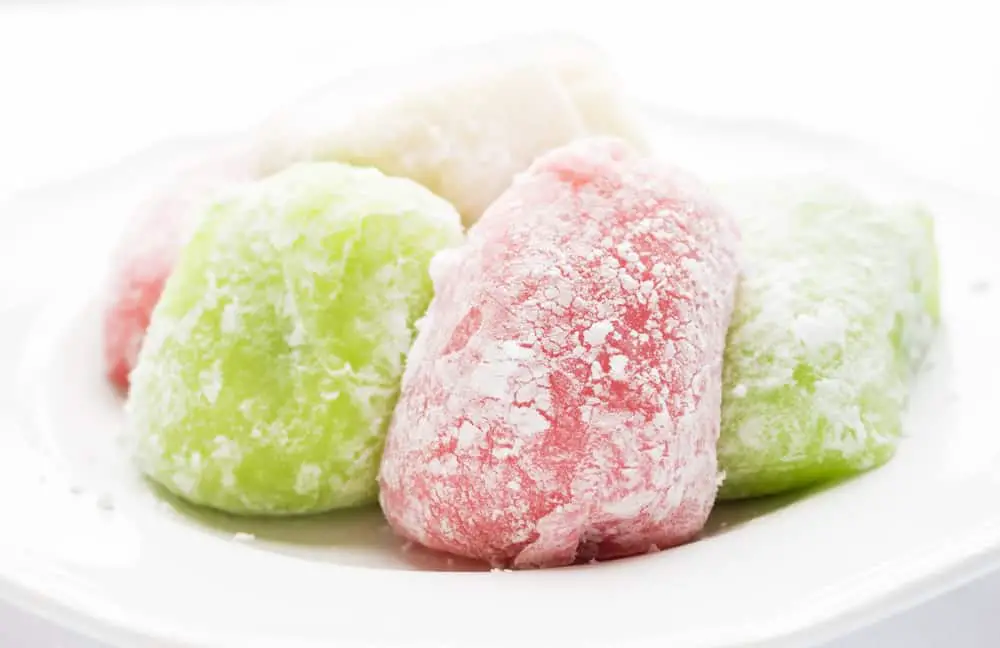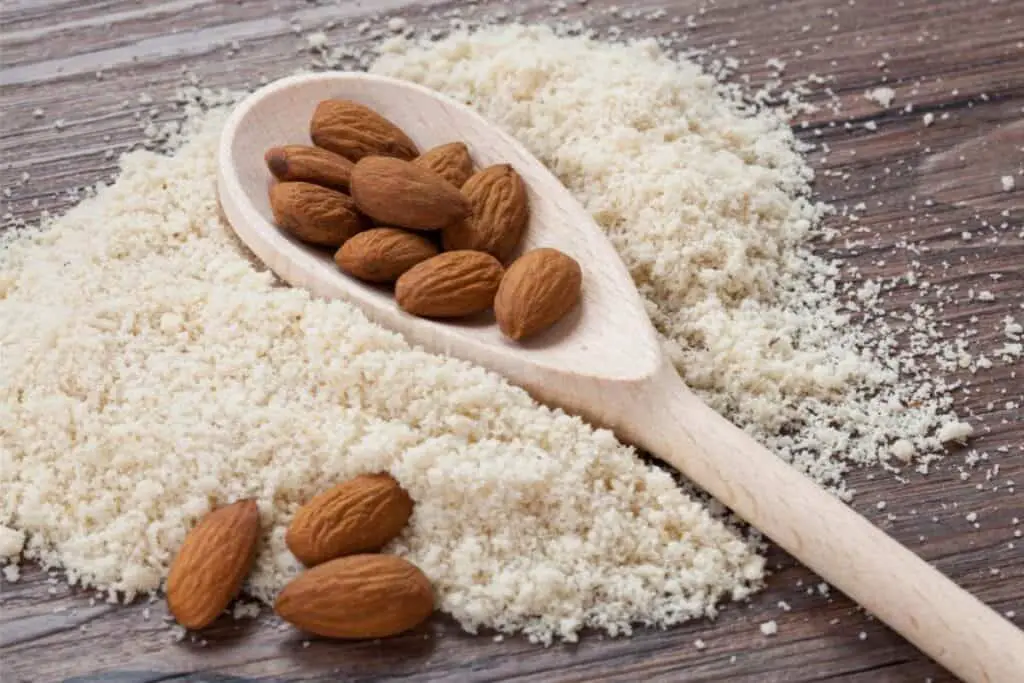Mochiko is a Japanese food product made from rice, which has been steamed and then ground into fine powder.
It is commonly used in the making of sweets such as mochi (glutinous rice cake) or in savory dishes like okonomiyaki. Read on to find out more about mochiko, its uses, nutritional value, and substitutes.
Mochiko – Sweet Rice Flour

Mochiko flour, also known as sweet rice flour, is a kind of flour that is made out of glutinous rice.
In Japan, where Mochiko flour originated, the flour is also known as Gyuhiko or Daifuku. It is known primarily for its chewy and sticky texture, and is used to make all kinds of Japanese sweets and pastry.
For example, it is the main component of mochi, a favorite Japanese dessert. In addition to being used in making sweets and pastries, Mochiko flour is also used in making breads and cakes. The most common use of Mochiko is in making cake batter.
Mochiko flour is a fine powdered flour, which can be made by washing sweet glutinous rice in water, which is then dehydrated and ground into a fine powder.
Mochiko has a doughy texture when being worked with, and is a little less elastic than other common glutinous rice derived flours, such as shiratamako flour.
It can be a little difficult to work with, as it does not dissolve in water, and can lose its bouncy elastic texture if left out in the air for too long – so just bear that in mind if you are planning on cooking, baking or making treats with this kind of flour.
Is Mochiko a Brand?
Mochiko is not a brand – rather, it is the name of the food itself. It is a variety of rice flour – just like how in the west we are very familiar with different kinds of wheat flour (think white, wholemeal, all purpose and self-raising).
However, there are popular brands that make mochiko, and have become household names for their wares. The most well known brand of Mochiko is Foo Lung Ching Kee.
Mochiko Flour Ingredients
Sweet glutinous rice is the only ingredient – and there are rarely any additives, as this can mess with the natural sticky texture of the flour when it is used in recipes.
The most commonly used type of mochiko is called “Koshi” – meaning “dried”, and this is what most people think of when they hear the word “mochiko”. Koshihikari is the best-known variety of koshi mochiko flour, but there are many others available.
The second most common type of mochiko is called “Hakusai”, which means “frozen”.
This is because it is produced using frozen raw material, and is therefore more suitable for baked goods.
Hakusai mochiko flour is usually sold in smaller quantities, and is often mixed with other types of flour to produce different textures.
There are a few rare cases of Mochiko with added ingredients, such as in the case of sweet mochiko, which contains sugar, as you would expect from the name.
Overall – most of the different kinds of mochiko that we have are differentiated by different uses of manufacturing processes, rather by different lists of ingredients!
Is Mochiko Flour the Same as Glutinous Rice Flour?
Mochiko rice flour is a kind of glutinous rice flour, so to an extent it is the same – but it is also worth bearing in mind that the rice flour you can find in your local grocery store probably won’t be the same as mochiko, and therefore can’t be used in the same ways.
If you live in the USA, you will probably need to buy your mochiko from a specialist retailer or from an online store.
Is Mochiko Flour Cooked?
Yes, it can be cooked and baked, making it delicious – you should actually always cook your rice flour, as it can carry bacteria that cause bacteria.
Heat treating the flour means that it is totally safe – but, if left unheated, it can cause stomach upsets.
There is also heating in the manufacturing process, as mochiko is made by washing and drying/dehydrating sweet glutinous rice in order to remove some starch, before grinding the dried grains into a fine powder.
The dehydrating step means that the rice is exposed to a low level of heat, which could kill off some dangerous bacteria. However, we suggest that you always heat your mochiko just to be on the safe side.
Can I Make Mochiko Flour?
You can certainly make it yourself, although it may take a little time to get the hang of it. Read on below to find our guide to making your own mochiko.
Homemade Mochiko Flour
You’ll need to start by washing your rice until the water comes back clear rather than cloudy – this could take a few goes.
Then drain the water out through a sieve (or use a colander), and leave the rice to dry out in a dehydrator for around 12 hours. Most new ovens have a ‘dehydrate’ setting, and you can even dehydrate in an air fryer.
If you don’t have the specific kit to dehydrate, set your oven to 150 – 200 degrees Fahrenheit for six to twelve hours – checking periodically to ensure the rice is not burning.
After that, grind the rice into a fine powder with a blender or food processor, or even with a special spice grinder to get that superfine consistency.
Substitutes
Unfortunately, if you are trying to make mochi or dango, then you cannot substitute the two mochi flours, mochiko and shiratamako.
The textures and flavors of all the other kinds of rice flour just do not match up to what is needed for that classic mochi, so you would probably be let down if attempting to use another kind of rice flour.

Other rice flours, and the generic rice flour you will find in your local supermarket, just won’t be suitable for making these kinds of desserts.
However, there are situations where you can use an alternative kind of glutinous rice flour as an alternative to mochiko flour. For example, if you are making a recipe that calls for mochiko as a thickening agent or binder, whether that be in soups, stews or noodles, you can probably replace it with another fine kind of rice flour, or even a fine milled starch, such as potato starch.
Can I Use Cornstarch for Mochiko Flour?
As we have already covered, no substitute holds a candle to mochiko when it comes to making Japanese sweets, bakes and desserts – nothing else has the flavor and texture of the rice flour.
That being said, there are situations where cornstarch is a suitable substitute, such as thickening soups and sauces, or binding noodles.
Nutrition
In terms of nutritional value, mochiko flour is similar to regular flour – containing protein, carbohydrates, fats and minerals.
Half of a cup of mochiko flour contains 41 grams of carbs, 1 gram of fiber, three grams of protein and 0.2 grams of fats. It also contains around 180 calories.
Is Mochiko Flour Gluten-Free?
Even though mochiko is made from glutinous rice, it is still gluten free! This is because glutinous rice doesn’t actually contain any gluten, despite the name.
Instead, ‘glutinous’ refers to the sticky texture that the rice develops when it is cooked, rather than the presence of the carb molecule gluten.
Do be careful though, as many packets of mochiko are made in factories that also process cereals and grains that contain gluten such as wheat, so there can be cross contamination.
If you are gluten intolerant then you should only eat mochiko or mochi if it is specifically labeled as gluten free,
Organic Mochiko
There is organic mochiko flour available on the market, but this is not the default, i.e., most of the mochiko flour you find on the market will not be organic. You will have to hunt out organic mochiko or sweet rice flour if you are dedicated to the organic lifestyle.
We recommend the Koda Farm brand for all your organic rice flour needs – they are organic, non-GMO, and even based in California, so you will avoid import taxes and excessive air miles.
Is Mochiko Flour Keto-Friendly?
No – all kinds of rice flour need to be avoided by those that are on keto diets, as it contains a huge number of net carbohydrates (about 77 g per 100 g serving).
Does Mochiko Flour Expire?
Like all forms of carbohydrates, mochiko flour does expire eventually, and both taste and texture degrade the longer that it is sitting on your shelf.
However, when stored in the right conditions, it can have a long shelf life. It can last indefinitely when in a completely airtight container, and kept in a freezer, but will spoil in around 6 to 12 months if just kept in a cupboard.
What to Make
There are a number of things that you can make with mochiko flour. Our favorite suggestions include:
– Hawaiian butter mochi – a sweet, gelatinous treat that has the tropical taste of coconut.
– Mochi with red beans – a Japanese classic, this mochi is one of the mochis that you have to try if you are getting into Japanese sweet treats.
– Mochi pancakes – this delicacy balances chewy and fluffy for a great sweet experience.
Where to Buy Mochiko Flour
As this is a specialist kind of flour, it is not common to find it in American grocery stores, unless you live in an area with a high Japanese population.
If you want to try one of the above suggestions for eating mochiko flour, then you will have to hunt it out at a specialist east Asian retailer, or purchase it online.
Amazon does carry a few brands as well – so you can even get it delivered the next day to your home!
Final Thoughts
In conclusion, Mochiko is a great Japanese staple to have in your kitchen cupboard if you love puddings such as mochi and dango, or if you want to give making dumplings or noodles a go.
